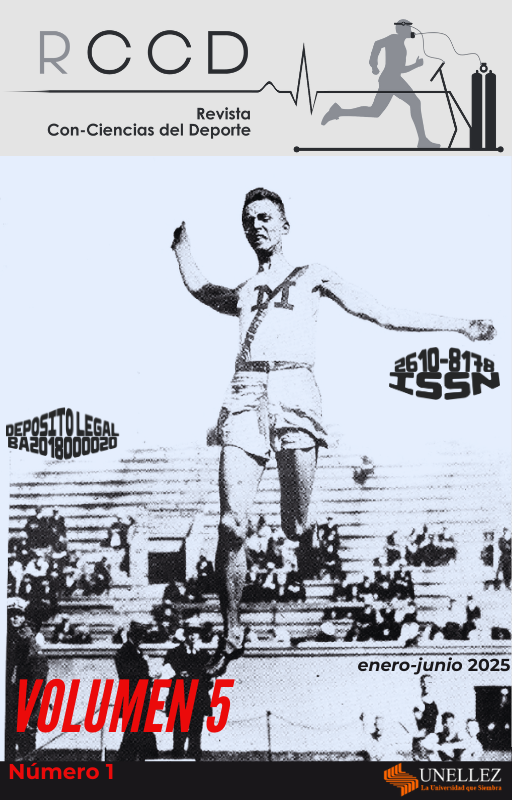La respuesta del lactato ante esfuerzos aeróbicos en niños y jóvenes: una revisión de paraguas
Palabras clave:
lactato, aeróbico, niños, jóvenesResumen
Esta revisión de paraguas integra evidencia actual sobre la cinética del lactato ante el ejercicio aeróbico en niños y jóvenes. Por lo cual, se realizó una búsqueda sistemática en diversas bases de datos y motores de búsqueda.Citas
Bertuzzi, R. C. D. M., Lima-Silva, A., Abad, C. C. C., & Pires, F. D. O. (2011). Metabolismo do lactato: Uma revisão sobre a bioenergética e a fadiga muscular. Revista Brasileira de Cineantropometria e Desempenho Humano, 11(2). https://doi.org/10.5007/1980-0037.2009v11n2p226
Birat, A., Bourdier, P., Piponnier, E., Blazevich, A. J., Maciejewski, H., Duché, P., & Ratel, S. (2018). Metabolic and Fatigue Profiles Are Comparable Between Prepubertal Children and Well-Trained Adult Endurance Athletes. Frontiers in Physiology, 9. https://doi.org/10.3389/fphys.2018.00387
Brooks, G. A. (2020). Lactate as a fulcrum of metabolism. Redox Biology, 35, 101454. https://doi.org/10.1016/j.redox.2020.101454
Endurance Training and Elite Young Athletes. (2011). En N. Armstrong & A. R. Barker, Medicine and Sport Science (pp. 59-83). S. Karger AG. https://doi.org/10.1159/000320633
Engel, F. A., Ackermann, A., Chtourou, H., & Sperlich, B. (2018). High-Intensity Interval Training Performed by Young Athletes: A Systematic Review and Meta-Analysis. Frontiers in Physiology, 9. https://doi.org/10.3389/fphys.2018.01012
Gunay, E., Coksevim, B., & Bediz, C. S. (2018). Effects of Aerobic Training on Biomechanical ond Lactate Responses in Sprint Swimming Performance in Adolescent Swimmers. Unpublished. https://doi.org/10.13140/RG.2.2.11418.54723
Hall, M. M., Rajasekaran, S., Thomsen, T. W., & Peterson, A. R. (2016). Lactate: Friend or Foe. PM&R, 8(3S). https://doi.org/10.1016/j.pmrj.2015.10.018
Jones, C., & Hammig, B. (2012). Epidemiology of exercise-related injuries among children. Health, 04(09), 625-628. https://doi.org/10.4236/health.2012.49098
Lehninger, A. L., Nelson, D. L., & Cox, M. M. (2009). Principios de bioquímica (5{̇487} ed). Omega.
Liu, Y., Wadey, C. A., Barker, A. R., & Williams, C. A. (2024). Process evaluation of school-based high-intensity interval training interventions for children and adolescents: A systematic review and meta-analysis of randomized controlled trials. BMC Public Health, 24(1). https://doi.org/10.1186/s12889-024-17786-6
Machado, F. A., Guglielmo, L. G. A., Greco, C. C., & Denadai, B. S. (2006). Slow component of VO2 in children during running exercise performed at heavy intensity domain: Analysis with different mathematical models.
Mocellin, R., Heusgen, M., & Gildein, H. P. (1991). Anaerobic threshold and maximal steady-state blood lactate in prepubertal boys. European Journal of Applied Physiology and Occupational Physiology, 62(1), 56-60. https://doi.org/10.1007/bf00635635
Nikitakis, I. S., Paradisis, G. P., Bogdanis, G. C., & Toubekis, A. G. (2019). Physiological Responses of Continuous and Intermittent Swimming at Critical Speed and Maximum Lactate Steady State in Children and Adolescent Swimmers. Sports, 7(1), 25. https://doi.org/10.3390/sports7010025
Pinazzo Rodríguez, J. R. (2024). EL LACTATO EN SANGRE EN DEPORTISTAS JÓVENES Y ADULTOS QUE REALIZAN DEPORTES CÍCLICOS. Revista Científica Multidimensional Magna Sapientia, 2(1), 34-42. https://doi.org/10.62308/e6yhjk65
Poon, E. T.-C., Sum, W. M.-K., Lubans, D., Wong, S. H.-S., & Ho, R. S.-T. (2024). High-intensity interval training for improving cardiometabolic health in children and adolescents: An umbrella review of systematic reviews. Journal of Sports Sciences, 42(23), 2199-2215. https://doi.org/10.1080/02640414.2024.2425910
Riddell, M. C. (2008). The endocrine response and substrate utilization during exercise in children and adolescents. Journal of Applied Physiology, 105(2), 725-733. https://doi.org/10.1152/japplphysiol.00031.2008
Robergs, R. A., Ghiasvand, F., & Parker, D. (2004). Biochemistry of exercise-induced metabolic acidosis. American Journal of Physiology-Regulatory, Integrative and Comparative Physiology, 287(3), R502-R516. https://doi.org/10.1152/ajpregu.00114.2004
Swanwick, E. (2018). Development of an Applied Model of Metabolic Energy Delivery from 3 Mechanisms. Biomedical Journal of Scientific & Technical Research, 5(4). https://doi.org/10.26717/bjstr.2018.05.001223
Villa Jiménez, I., Aguilar Cordero, M. J., Guisado Barrilao, R., Naranjo Orellana, J., & Guerrero Almeida, L. (2016). Ventilación y lactato sanguíneo en niños durante una prueba máxima incremental en cicloergómetro. Nutrición Hospitalaria, 33(2). https://doi.org/10.20960/nh.132
Westerblad, H., & Allen, D. G. (2002). Fatiga Muscular: ¿La Causa Principal es el Ácido Láctico o los Fosfatos Inorgánicos?
Zając, B. (2024). Analysis of Course of Changes in Blood Lactate Concentration in Response to Graded Exercise Test and Modified Wingate Test in Adolescent Road Cyclists. Journal of Clinical Medicine, 13(2), 535. https://doi.org/10.3390/jcm13020535
Descargas
Publicado
Cómo citar
Número
Sección
Licencia
Derechos de autor 2025 Revista Con - Ciencias del Deporte

Esta obra está bajo una licencia internacional Creative Commons Atribución-CompartirIgual 4.0.





